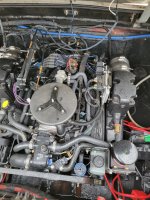Just winterized my engine today 5.0 Mercruiser. Emptied all the fresh water in the engine thru the single point system. Removed the thermostat. Then placed a big jug of antifreeze on swim platform at stern and hosed it to the muffs. Opened the jug faucet and AF starting to leak down on the muffs, showing there is enough liquid. Turned the engine on, it started to suck the AF in. It probably sucked around two gallons. Waiting to see some liquid on the exhaust, somehow, I got stressed and turned the engine off. I decided to fill the engine with AF from the thermostat opening (I should have done it before, but no big deal I thought). I completely filled the engine with AF (it took about 2.5 gallons), so thermostat opening overflowed, meaning completely full. I went back to the AF jug at the stern, opened the jug faucet, observed the AF continue, and turned the engine on.
Nothing coming from the exhaust, no water, no AF, no liquid. All the AF from jug is leaking over the muffs to the tray on the ground, but nothing coming out from the exhaust.
Other than the muffs, there is some AF is coming from the inside of propeller hole.
What is happening??
Many thanks
Nothing coming from the exhaust, no water, no AF, no liquid. All the AF from jug is leaking over the muffs to the tray on the ground, but nothing coming out from the exhaust.
Other than the muffs, there is some AF is coming from the inside of propeller hole.
What is happening??
- Did I do something wrong by running the engine empty? (i.e. no cooling liquid, whatever it takes from muffs)
- I had run it on the muffs many times using the garden hose previously, with plenty of pressure, at the beginning of summer. From the jug, the pressure is much smaller of course. Is it a big deal?
- Is the AF coming from inside of propeller, is it the excess liquid going into muffs? (I haven't noticed it before, didn't bother since I observed the liquid coming from exhaust all the time when running on muffs)
- Since the engine is full of AF, any kind of testing will have to wait till next summer.
- Has my engine winterization been successful?
Many thanks






















